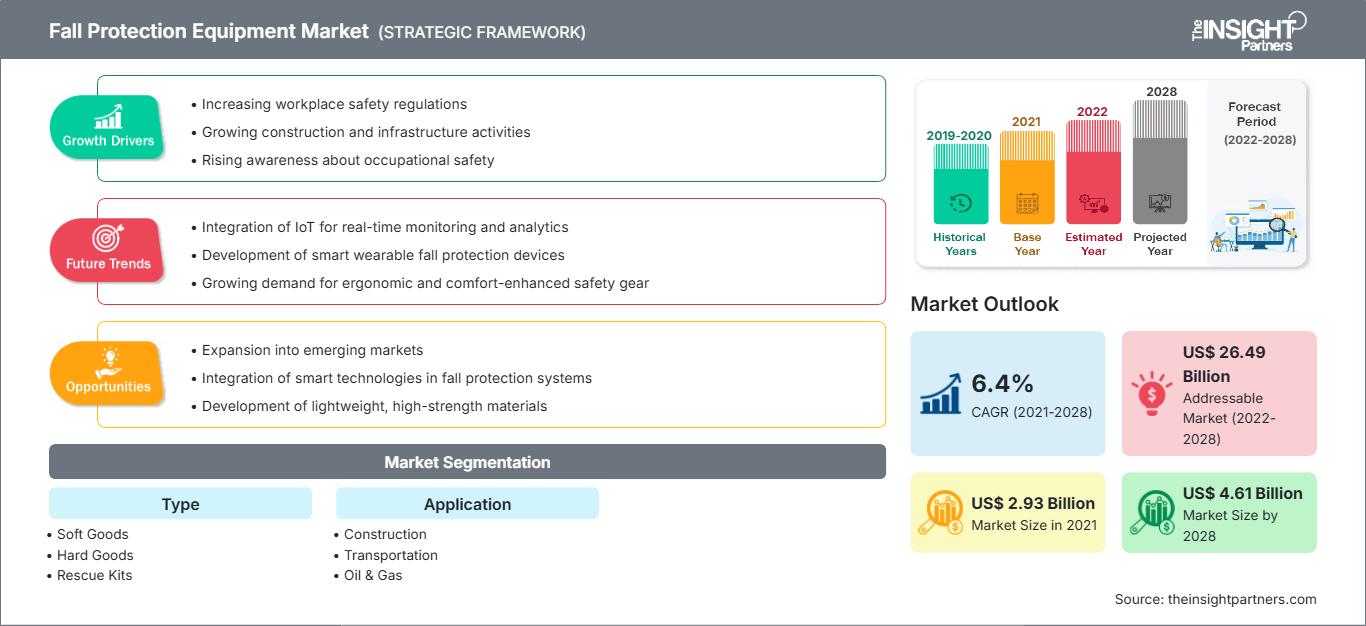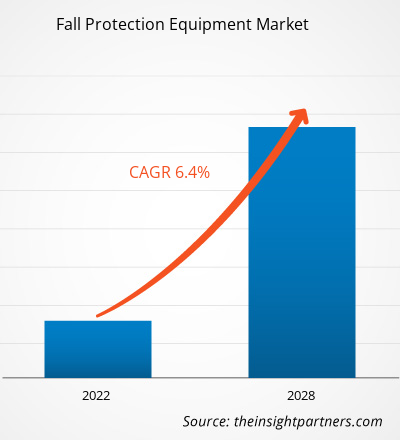Der Markt für Absturzsicherungsausrüstung soll von 2.934,86 Millionen US-Dollar im Jahr 2021 auf 4.606,61 Millionen US-Dollar im Jahr 2028 wachsen; für den Zeitraum 2021–2028 wird eine durchschnittliche jährliche Wachstumsrate (CAGR) von 6,4 % erwartet.
Die schnelle Industrialisierung in den Industrie- und Entwicklungsländern ist einer der Hauptfaktoren für das Marktwachstum. Aufgrund fehlender angemessener Sicherheitsverfahren in verschiedenen Fertigungs-, Bergbau- und anderen Industrieanlagen treten zunehmend Berufsrisiken auf. Im Vergleich zu anderen Ländern legen die USA mehr Wert auf die Sicherheit und Gesundheit ihrer Arbeitnehmer, was die Einführung von Absturzsicherungsausrüstung im Land vorantreibt. Zur Überwachung der Sicherheitsnormen und -verfahren hat das Land bestimmte Behörden wie die Occupational Safety and Health Administration (OSHA) und das American National Standards Institute (ANSI) eingerichtet. Die OSHA ist eine Organisation für Gesundheits- und Sicherheitsvorschriften und deren Einhaltung, die Arbeitnehmern 10- und 30-stündige Schulungen zu den für verschiedene Berufe relevanten OSHA-Vorschriften und -Standards am Arbeitsplatz anbietet. Der zunehmende Fokus auf Sicherheitspraktiken am Arbeitsplatz und die Verbesserung der staatlichen Vorschriften zur Arbeitssicherheit in Europa und Asien haben den Markt jedoch angetrieben. Steigende Bautätigkeiten und der aufgrund der steigenden Bevölkerung wachsende Öl- und Gassektor in asiatischen Ländern wie Indien und China dürften das Marktwachstum im Prognosezeitraum ankurbeln. Die zunehmende Urbanisierung und das Wachstum der Öl- und Gasindustrie gehören zu den Hauptfaktoren, die das Marktwachstum für Absturzsicherungsausrüstung in den Regionen MEA (Naher Osten und Afrika) und SAM (Südamerika) unterstützen.
Passen Sie diesen Bericht Ihren Anforderungen an
Sie erhalten kostenlos Anpassungen an jedem Bericht, einschließlich Teilen dieses Berichts oder einer Analyse auf Länderebene, eines Excel-Datenpakets sowie tolle Angebote und Rabatte für Start-ups und Universitäten.
Markt für Absturzsicherungsausrüstung: Strategische Einblicke

-
Holen Sie sich die wichtigsten Markttrends aus diesem Bericht.Dieses KOSTENLOSE Beispiel umfasst Datenanalysen, die von Markttrends bis hin zu Schätzungen und Prognosen reichen.
Der COVID-19-Ausbruch hatte auch 2021 in mehreren Ländern negative Auswirkungen. Produktionsschließungen oder eingeschränkte Geschäftsabläufe sowie Lockdowns und Reisebeschränkungen behinderten die Produktion und Lieferkette von Absturzsicherungsausrüstung. Die konstante Nachfrage nach Absturzsicherungsausrüstung verzeichnete 2020 aufgrund des von der Regierung verhängten Lockdowns und einer geringen Anzahl von Bauprojekten einen leichten Rückgang. Im Jahr 2021 besteht jedoch aufgrund einer Zunahme der Bautätigkeiten, der Öl- und Gasexploration sowie von Telekommunikationsprojekten eine Nachfrage nach Absturzsicherungsausrüstung, um die Sicherheit der Mitarbeiter zu gewährleisten. Auch der E-Commerce hat dazu beigetragen, den Bedarf an Absturzsicherungsausrüstung im Bausektor zu steigern.
Markteinblicke in Absturzsicherungsausrüstung: Anstieg der Bautätigkeit
Der Anstieg der Bautätigkeit weltweit ist ein Hauptfaktor, der den Markt für Absturzsicherungsausrüstung antreibt. Da asiatische Länder wie Indien und China ein starkes Bevölkerungswachstum verzeichnen, steigt die Nachfrage nach Gewerbe- und Wohnflächen in diesen Ländern stetig. Die Weltwirtschaft erlebt derzeit einen starken Abschwung aufgrund der sich entwickelnden Kreditknappheit, die dazu führt, dass Volkswirtschaften weltweit ihre Entwicklungsziele verfehlen. Infrastruktur hat im aktuellen Szenario weiterhin höchste Priorität, um Entwicklungslücken zu schließen, da sie als allmächtig und in der Lage gilt, Volkswirtschaften aus finanziellen Turbulenzen zu führen. Regierungen auf der ganzen Welt pumpen Geld in die physische und soziale Infrastruktur, um die Nachfrage nach Produkten und Dienstleistungen durch die Schaffung von Arbeitsplätzen zu steigern.
Typbasierte Markteinblicke
Basierend auf dem Typ ist der Markt für Absturzsicherungsausrüstung in weiche Güter, harte Güter, Rettungssets, Körpergurte, Ganzkörpergurte und Sonstiges unterteilt. Das Segment der harten Güter ist das führende Segment, da es erhöhte Sicherheit bietet. Darüber hinaus soll die zunehmende Innovation in diesem Segment das Marktwachstum ankurbeln. Die steigende Nachfrage nach Ganzkörpergurtsystemen seitens aller industriellen Anwender trägt jedoch dazu bei, dass das Segment mit der höchsten durchschnittlichen jährlichen Wachstumsrate (CAGR) wächst.
Anwendungsbasierte Markteinblicke
In Bezug auf die Anwendung ist der Markt für Absturzsicherungsausrüstung in die Branchen Bauwesen, Öl und Gas, Transport, Energie und Versorgung sowie Telekommunikation unterteilt. Um einen reibungslosen Ablauf der Aktivitäten zu gewährleisten und die Sicherheit der Arbeiter aufrechtzuerhalten, benötigt jede Branche Absturzsicherungsausrüstung in ihren Einrichtungen. Im Jahr 2020 hatte das Bauwesen den größten Marktanteil.
Die Akteure auf dem Markt für Absturzsicherungsausrüstung verfolgen Strategien wie Fusionen, Übernahmen und Marktinitiativen, um ihre Position auf dem Markt zu behaupten. Im Folgenden sind einige Entwicklungen der wichtigsten Akteure aufgeführt:
- Im Mai 2021 brachte die Pure Safety Group ihre Familie von Höhensicherheitsmarken – Stronghold by PSG, Ty-Flt, Checkmate und HART – unter das Banner des Guardian. Durch diese Expansion ist Guardian nun die weltweit größte unabhängige Marke für Absturzsicherung und -prävention.
- 3M Fall Protection hat bis Ende März 2021 Suspension Trauma Safety Straps erfunden und in alle ANSI- und CSA-zertifizierten 3M DBI SALA-Gurte integriert.
Markt für Absturzsicherungsausrüstung
Die Analysten von The Insight Partners haben die regionalen Trends und Faktoren, die den Markt für Absturzsicherungen im Prognosezeitraum beeinflussen, ausführlich erläutert. In diesem Abschnitt werden auch die Marktsegmente und die geografische Lage in Nordamerika, Europa, dem asiatisch-pazifischen Raum, dem Nahen Osten und Afrika sowie Süd- und Mittelamerika erörtert.Umfang des Marktberichts zu Absturzsicherungsausrüstung
| Berichtsattribut | Einzelheiten |
|---|---|
| Marktgröße in 2021 | US$ 2.93 Billion |
| Marktgröße nach 2028 | US$ 4.61 Billion |
| Globale CAGR (2021 - 2028) | 6.4% |
| Historische Daten | 2019-2020 |
| Prognosezeitraum | 2022-2028 |
| Abgedeckte Segmente |
By Typ
|
| Abgedeckte Regionen und Länder |
Nordamerika
|
| Marktführer und wichtige Unternehmensprofile |
|
Dichte der Marktteilnehmer für Absturzsicherungsausrüstung: Verständnis ihrer Auswirkungen auf die Geschäftsdynamik
Der Markt für Absturzsicherungsausrüstung wächst rasant. Dies wird durch die steigende Nachfrage der Endverbraucher aufgrund veränderter Verbraucherpräferenzen, technologischer Fortschritte und eines stärkeren Bewusstseins für die Produktvorteile vorangetrieben. Mit der steigenden Nachfrage erweitern Unternehmen ihr Angebot, entwickeln Innovationen, um den Bedürfnissen der Verbraucher gerecht zu werden, und nutzen neue Trends, was das Marktwachstum weiter ankurbelt.
- Holen Sie sich die Markt für Absturzsicherungsausrüstung Übersicht der wichtigsten Akteure
- Weichwaren
- Hartwaren
- Rettungssets
- Körpergurte
- Auffanggurte
- Sonstige
Nach Anwendung
- Bau
- Transport
- Öl und Gas
- Bergbau
- Energie und Versorgung
- Telekommunikation
- Sonstige
Nach Geografie
-
Nord Amerika
- USA
- Kanada
- Mexiko
-
Europa
- Frankreich
- Deutschland
- Italien
- Großbritannien
- Russland
- Restliches Europa
-
Asien-Pazifik (APAC)
- China
- Indien
- Südkorea
- Japan
- Australien
- Restliches APAC
-
Naher Osten & Afrika (MEA)
- Südafrika
- Saudi-Arabien
- VAE
- Rest von MEA
-
Südamerika (SAM)
- Brasilien
- Argentinien
- Rest von SAM
Firmenprofile
- 3M
- Falltech
- French Creek Production
- Frontline
- Guardian Fall Protection
- Kee Safety
- KwikSafety
- MSA Safety Incorporated
- Honeywell International Inc.
- Tritech Fall Protection
- Historische Analyse (2 Jahre), Basisjahr, Prognose (7 Jahre) mit CAGR
- PEST- und SWOT-Analyse
- Marktgröße Wert/Volumen – Global, Regional, Land
- Branchen- und Wettbewerbslandschaft
- Excel-Datensatz
Aktuelle Berichte
Erfahrungsberichte
Grund zum Kauf
- Fundierte Entscheidungsfindung
- Marktdynamik verstehen
- Wettbewerbsanalyse
- Kundeneinblicke
- Marktprognosen
- Risikominimierung
- Strategische Planung
- Investitionsbegründung
- Identifizierung neuer Märkte
- Verbesserung von Marketingstrategien
- Steigerung der Betriebseffizienz
- Anpassung an regulatorische Trends






















 Kostenlose Probe anfordern für - Markt für Absturzsicherungsausrüstung
Kostenlose Probe anfordern für - Markt für Absturzsicherungsausrüstung